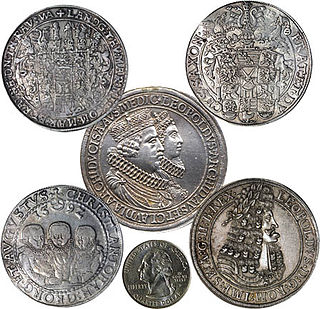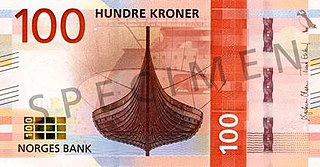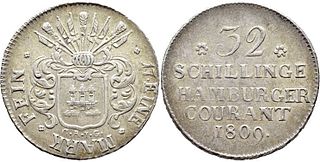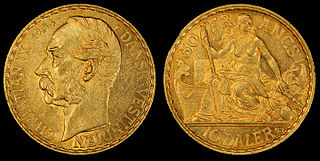
A thaler or taler is one of the large silver coins minted in the states and territories of the Holy Roman Empire and the Habsburg monarchy during the Early Modern period. A thaler size silver coin has a diameter of about 40 mm and a weight of about 25 to 30 grams. The word is shortened from Joachimsthaler, the original thaler coin minted in Joachimsthal, Bohemia, from 1520.

The krone, plural kroner, is the currency of the Kingdom of Norway. It was traditionally known as the Norwegian crown in English, however, this has fallen out of common usage. It is nominally subdivided into 100 øre, although the last coins denominated in øre were withdrawn in 2012.

The svenska riksdaler was the name of a Swedish coin first minted in 1604. Between 1777 and 1873, it was the currency of Sweden. The daler, like the dollar, was named after the German Thaler. The similarly named Reichsthaler, rijksdaalder, and rigsdaler were used in Germany and Austria-Hungary, the Netherlands, and Denmark-Norway, respectively. Riksdaler is still used as a colloquial term for krona, Sweden's modern-day currency.

The krone is the official currency of Denmark, Greenland, and the Faroe Islands, introduced on 1 January 1875. Both the ISO code "DKK" and currency sign "kr." are in common use; the former precedes the value, the latter in some contexts follows it. The currency is sometimes referred to as the Danish crown in English, since krone literally means crown. Historically, krone coins have been minted in Denmark since the 17th century.

The Scandinavian Monetary Union was a monetary union formed by Denmark and Sweden on 5 May 1873, with Norway joining in 1875. It established a common currency unit, the krone/krona, based on the gold standard. It was one of the few tangible results of the Scandinavian political movement of the 19th century. The union ended during World War I.

A non-decimal currency is a currency that has sub-units that are a non-decimal fraction of the main unit, i.e. the number of sub-units in a main unit is not a power of 10. Historically, most currencies were non-decimal, though today virtually all are now decimal.

The Reichsthaler, or more specifically the Reichsthaler specie, was a standard thaler silver coin introduced by the Holy Roman Empire in 1566 for use in all German states, minted in various versions for the next 300 years, and containing 25–26 grams fine silver.

The rijksdaalder was a Dutch coin first issued by the Republic of the Seven United Netherlands in the late 16th century during the Dutch Revolt which featured an armored half bust of William the Silent. It was the Dutch counterpart of the Reichsthaler of the Holy Roman Empire but weighed slightly less, at 29.03 g of 0.885 fine silver, reduced to 0.875 fine by the 17th century. Friesland, Gelderland, Holland, Kampen, Overijssel, Utrecht, West Friesland, Zeeland, and Zwolle minted armored half bust rijksdaalders until the end of the 17th century.
The skilling was the Scandinavian equivalent of the shilling. It was used as a subdivision of the various kinds of currencies named rigsdaler in use throughout Scandinavia, including the Danish rigsdaler, the Norwegian rigsdaler, and the Swedish riksdaler.

The Austro-Hungarian gulden was the currency of the lands of the House of Habsburg between 1754 and 1892, when it was replaced by the Austro-Hungarian krone as part of the introduction of the gold standard. In Austria, the gulden was initially divided into 60 kreuzers. The currency was decimalized in 1857, using the same names for the unit and subunit.
The South German Gulden was the currency of the states of Southern Germany between 1754 and 1873. These states included Bavaria, Baden, Württemberg, Frankfurt and Hohenzollern. It was divided into 60 kreuzer, with each kreuzer worth 4 pfennig or 8 heller.

The Hamburg Mark refers to two distinct currencies issued in the city of Hamburg until 1875:

The daler was the currency of the Danish West Indies between 1849 and 1917, and of the United States Virgin Islands between 1917 and 1934.
The rigsdaler was the currency of the Danish West Indies until 1849. It was subdivided into 96 skilling. The rigsdaler was equal to 4⁄5 Danish rigsdaler. The rigsdaler was replaced by the daler.
The Speciethaler was the currency of Schleswig-Holstein until 1866, located in the border region of present-day Denmark and Germany.

The rigsdaler specie was a unit of silver currency used in Norway from 1544, renamed as the speciedaler in 1816 and used until 1873. Norway used a common reichsthaler currency system shared with Denmark, Hamburg and Schleswig-Holstein until 1873 when the gold standard was implemented in Scandinavia and the German Empire.

The rigsdaler was the currency of Greenland until 1874. It was equal to the Danish rigsdaler which circulated in Greenland alongside distinct banknotes from 1803.

The Greenlandic krone was a planned currency for Greenland, plans of which were abandoned in 2009. The same name is often used for currency issued during Greenland's time as a Danish colony. The name krone is derived from the Danish krone, introduced in an 1873 currency reform that replaced Danish mark and skilling.
The North German thaler was a currency used by several states of Northern Germany from 1690 to 1873, first under the Holy Roman Empire, then by the German Confederation. Originally equal to the Reichsthaler specie or silver coin from 1566 until the Kipper und Wipper crisis of 1618, a thaler currency unit worth less than the Reichsthaler specie was first defined in 1667 and became widely used after adoption of the Leipzig currency standard of 1690.

The schilling was the name of a coin in various historical European states and which gave its name to the English shilling. The schilling was a former currency in many of the German-speaking states of the Holy Roman Empire, including the Hanseatic city states of Hamburg and Lübeck, the March of Brandenburg, and the Duchies of Bavaria, Mecklenburg, and Württemberg. It was also used in Switzerland and in Austria, where silver schillings were introduced as recently as 1923.


















